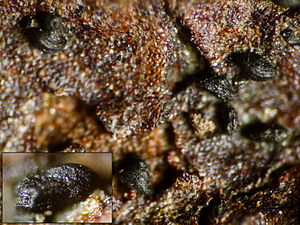Mytilinidiales
| Mytilinidiales | ||||||||||||
|---|---|---|---|---|---|---|---|---|---|---|---|---|

|
||||||||||||
| Systematics | ||||||||||||
|
||||||||||||
| Scientific name | ||||||||||||
| Mytilinidiales | ||||||||||||
| E. Boehm , CL Schoch & Spatafora |
The Mytilinidiales are an order of the Pleosporomycetidae within the division of the sac fungi .
features
The mytilinidiales form so-called pseudothecia as fruiting bodies . These are spherical to obovate to the sides strongly compressed, upright, oyster-shaped or ax-shaped. They stand upright, with the side walls more or less close together and vertically elongated to form a longitudinal keel or a comb-shaped tip. The peridium is parenchymal and thin-walled, and encloses a hemathecium (the tissue between the tubes ), which consists of narrow bar-like pseudoparaphyses and arises from a gel matrix. When ripe, however, it is often very sparse or completely absent. The bitunicate tubes develop basally, rarely also laterally, and contain eight spores that are arranged in an overlapping single row (uniseriat) or two rows (biseriat) or in tufts. They are translucent , yellow to dark brown, and often show bipolar asymmetry . They are very diverse in their shape.
Way of life and distribution
Representatives of the Mytilinidiaceae family are mostly saprobic on woody tissue, especially on naked samers . Few species live with algae as lichens . They are widespread, especially in temperate areas. Representatives of the Gloniaceae are also saprobic . However, the widespread species Cenococcum geophilum forms an ectomycorrhiza with a large number of plants.
Systematics and taxonomy
The order of the Mytilinidiales was first described in 2009 by Eric WA Boehm , Conrad L. Schoch and Joseph W. Spatafora in order to place the family of the Mytilinidiaceae within the Pleosporomycetidae . The genera Glonium and the genus Cenococcum with the only widespread species Cenococcum geophilum belonged to the family so far, but both are, supported by phylogenetic data, placed in a separate family Gloniaceae within the order of the Mytilinidiales. However, this assignment is still controversial. The NCBI counts instead of the Gloniaceae the family Argynnaceae to the order of the Mytilinidiales.
The order currently consists of two families with three or 10 genera:
Individual evidence
- ↑ a b Eric WA Boehm, Conrad L. Schoch, Joseph W. Spatafora: On the evolution of the Hysteriaceae and Mytilinidiaceae (Pleosporomycetidae, Dothideomycetes, Ascomycota) using four nuclear genes . In: Mycological Research . tape 113 , no. 4 , 2009, p. 461-479 , doi : 10.1016 / j.mycres.2008.12.001 .
- ^ Paul F. Cannon, Paul M. Kirk: Fungal families of the world . CABI Europe, Wallingford, Oxfordshire (UK) 2007, ISBN 978-0-85199-827-5 , pp. 233-234 ( available online ).
- ↑ Spatafora, JW, Owensby, CA, Douhan, GW, Boehm, EW, & Schoch, CL: Phylogenetic placement of the ectomycorrhizal genus Cenococcum in Gloniaceae (Dothideomycetes) . In: Mycologia . tape 104 , no. 3 , 2012, p. 758-765 , doi : 10.3852 / 11-233 .
- ^ Mytilinidiales . In: MycoBank . Mycobank, accessed April 27, 2018 .
- ↑ Eric WA Boehm, GK Mugambi, SM Huhndorf, S. Marincowitz, Joseph W. Spatafora, Conrad L. Schoch: A molecular phylogenetic reappraisal of the Hysteriaceae, Mytilinidiaceae and Gloniaceae (Pleosporomycetidae species, Dothideomycetes) with keys to world . In: Studies in Mycology . tape 64 , 2009, p. 49-83 , doi : 10.3114 / sim.2009.64.03 .
- ^ Mytilinidiales . In: NCBI . NCBI, accessed April 27, 2018 .
- ↑ Nalin N. Wijayawardene, Kevin D. Hyde, H. Thorsten Lumbsch, Jian Kui Liu, Sajeewa SN Maharachchikumbura, Anusha H. Ekanayaka, Qing Tian, Rungtiwa Phookamsak: Outline of Ascomycota: 2017 . In: Fungal Diversity . tape 88 , 2018, p. 167-263 , doi : 10.1007 / s13225-018-0394-8 .